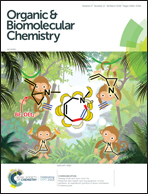Trehalose-cored amphiphiles for membrane protein stabilization: importance of the detergent micelle size in GPCR stability†
Abstract
Despite their importance in biology and medicinal chemistry, structural and functional studies of membrane proteins present major challenges. To study diverse membrane proteins, it is crucial to have the correct detergent to efficiently extract and stabilize the proteins from the native membranes for biochemical/biophysical downstream analyses. But many membrane proteins, particularly eukaryotic ones, are recalcitrant to stabilization and/or crystallization with currently available detergents and thus there are major efforts to develop novel detergents with enhanced properties. Here, a novel class of trehalose-cored amphiphiles are introduced, with multiple alkyl chains and carbohydrates projecting from the trehalose core unit are introduced. A few members displayed enhanced protein stabilization behavior compared to the benchmark conventional detergent, n-dodecyl-β-D-maltoside (DDM), for multiple tested membrane proteins: (i) a bacterial leucine transporter (LeuT), (ii) the R. capsulatus photosynthetic superassembly, and (iii) the human β2 adrenergic receptor (β2AR). Due to synthetic convenience and their favourable behaviors for a range of membrane proteins, these agents have potential for membrane protein research. In addition, the detergent property–efficacy relationship discussed here will guide future design of novel detergents.



 Please wait while we load your content...
Please wait while we load your content...